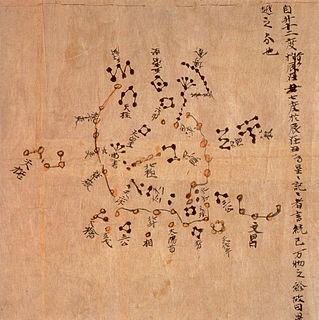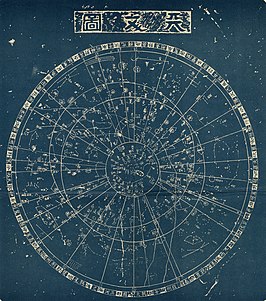The modern constellation Triangulum Australe is not included in the Three Enclosures and Twenty-Eight Mansions system of traditional Chinese uranography because its stars are too far south for observers in China to know about them prior to the introduction of Western star charts. Based on the work of Xu Guangqi and the German Jesuit missionary Johann Adam Schall von Bell in the late Ming Dynasty, [1] this constellation has been classified as one of the 23 Southern Asterisms (近南極星區, Jìnnánjíxīngōu) under the name Triangle (三角形, Sānjiǎoxíng).

Triangulum Australe is a small constellation in the far Southern Celestial Hemisphere. Its name is Latin for "the southern triangle", which distinguishes it from Triangulum in the northern sky and is derived from the almost equilateral pattern of its three brightest stars. It was first depicted on a celestial globe as Triangulus Antarcticus by Petrus Plancius in 1589, and later with more accuracy and its current name by Johann Bayer in his 1603 Uranometria. The French explorer and astronomer Nicolas Louis de Lacaille charted and gave the brighter stars their Bayer designations in 1756.

The Twenty-Eight Mansions, hsiu, xiu or sieu are part of the Chinese constellations system. They can be considered as the equivalent to the zodiacal constellations in Western astronomy, though the Twenty-eight Mansions reflect the movement of the Moon through a sidereal month rather than the Sun in a tropical year.

Xu Guangqi or Hsü Kuang-ch'i, also known by his baptismal name Paul, was a Chinese scholar-bureaucrat, Catholic convert, agricultural scientist, astronomer, and mathematician under the Ming dynasty. Xu was a colleague and collaborator of the Italian Jesuits Matteo Ricci and Sabatino de Ursis and assisted their translation of several classic Western texts into Chinese, including part of Euclid's Elements. He was also the author of the Nong Zheng Quan Shu, a treatise on agriculture. He was one of the "Three Pillars of Chinese Catholicism". His current title is Servant of God. On April 15, 2011, Vatican spokesman Federico Lombardi announced the beatification of Xu Guangqi.
Contents
The name of the western constellation in modern Chinese is 南三角座 (nán sān jiǎo zuò), meaning "the southern triangle constellation".

